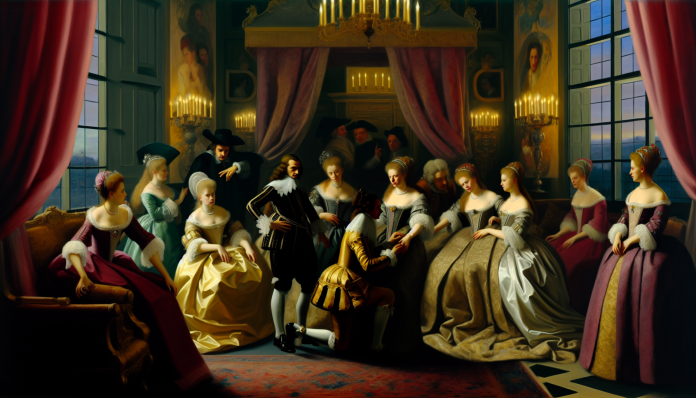Introduction
In the court of Charles II, the air was perpetually thick with intrigue, flirtation, and scandal. He was not just a king; he was a symbol of sensuality and excess in the Restoration era of England—a period marked by the end of Puritanical rule and the return to monarchy. This article delves into the wild sex life of King Charles II, illustrating how his romances and numerous mistresses became defining elements of his reign, and examining the societal norms of the 17th century in contrast to today’s more liberated perspectives on sexuality.
The Scandal
Charles II ascended to the throne in 1660 following years of civil war and a strict Puritanical regime. After the execution of his father, Charles I, and a lengthy exile, Charles II’s return was celebrated as a restoration of not just the monarchy but also of hedonistic pleasures. Known for his charm and attractive demeanor, Charles II quickly came to be referred to as “the Merry Monarch.”
A Parade of Mistresses
Historically, Charles’s romantic entanglements are well-documented, with over a dozen notable mistresses entering and exiting his life. Among these were:
-
Barbara Villiers, the Countess of Castlemaine: One of his most infamous loves, she became his mistress shortly after his restoration. The relationship was scandalous; she was married and known for her many affairs. Barbara bore Charles five children, yet remained a divisive figure. Described as “a celebrated beauty” of her time, she was both revered and reviled.
-
Nell Gwyn: An actress and the daughter of a tallow chandler, Nell captured Charles’s heart in a different manner. Famous for her beauty and wit, Nell’s relationship with the king was both romantic and politically astute. Known for her down-to-earth demeanor, she is perhaps best remembered for the quip that she hoped to keep “the king’s favor.” She would eventually become the mother of two of Charles’s children.
- Louise de Kérouaille: A Frenchwoman whose influence over Charles was significant, especially in the context of increasing tensions between England and France. She arrived in England as a lady-in-waiting and became a vehicle for political strategies, yet her affair with the king was one of genuine affection.
The drama surrounding these relationships created a spectacle in England, drawing public fascination. Charles mingled courtly duties with an unabashed pursuit of pleasure, leading one historian to describe his reign as “a carnival of lust.”
Public Reaction
Public reaction to Charles’s cavalier attitude towards relationships was mixed. While many were entertained, others were horrified, especially those still embedded in the lingering moral strictures of the Puritan regime. Satirical literature flourished, lampooning both the king and his mistresses. The Bard of the era was unrelenting, with poets and writers alike using their craft to explore and criticize the royal affairs.
A popular print from the time, “The Royal Bawdy,” showcased the king’s sexual exploits in exaggerated and humorous ways, contributing to the notion that monarchs were removed from normal societal morals. Despite criticism, such depictions also popularized the idea of the monarch as a figure of whimsical infallibility, shockingly liberated from prudence.
Moral and Cultural Analysis
Societal Reaction
At the time, England was in the throes of shifting societal norms. The restoration of the monarchy welcomed a return to lavish court life, but it also brought about an underlying tension regarding morality. While many were entertained by the sexual escapades of their monarch, others—largely those loyal to the earlier Puritan order—viewed the excess as scandalous and a sign of moral decay. The resulting cultural clash signaled the ongoing struggle between the ideals of sexual repression and liberation.
Consequences for the Involved
While the women involved in these relationships experienced both social prestige and stigma, the king himself emerged largely unscathed, his status as a ruler shielding him from direct consequence. Yet, the consequences of his promiscuity rippled through political alliances and influenced foreign relations.
In contrast, many of the women, none more evidently than Barbara Villiers and Nell Gwyn, faced public scrutiny. While the king retained his palace, the mistresses often endured the societal repercussions of their liaisons. Nell, for instance, embraced the public spotlight, eventually finding herself celebrated even as she faced moral backlash.
Modern Perspectives
If the affairs of Charles II transpired in today’s digital world, the response could be vastly more pronounced. Contemporary liberal values offer a stark contrast to the subjectivity of 17th-century morality. Today, the narrative of power dynamics and consent are at the forefront of societal discourse, opening a dialogue about how similarly situated people navigate sexual relationships—especially within hierarchical structures.
In a current context, Charles II might be analyzed through the lens of feminist critiques concerning agency, power, and consent, significantly altering how his actions would be interpreted. Discussions around infidelity, exploitation, and privilege would dominate the conversation, highlighting entrenched social hierarchies.
Conclusion
The numerous affairs of Charles II stand as a vibrant testament to the complexities of human desire, the kaleidoscopic nature of morality, and the tensions between personal freedom and societal expectations. The narrative of his escapades reveals a layered history in which sexual exploration was both a privilege and a risk—a dance that continues to define human experiences.
As we reflect upon this period, we are urged to think critically about our contemporary values and social structures. The echoes of the past resonate in today’s conversations around sex, power, and relationships, reminding us that history is not merely a collection of events but a living, breathing evolution of societal norms and human behavior. So, the next time we come across an historical scandal, let’s remember there’s more to the story—these tales are intricately woven into the very fabric of our present moral landscape.

